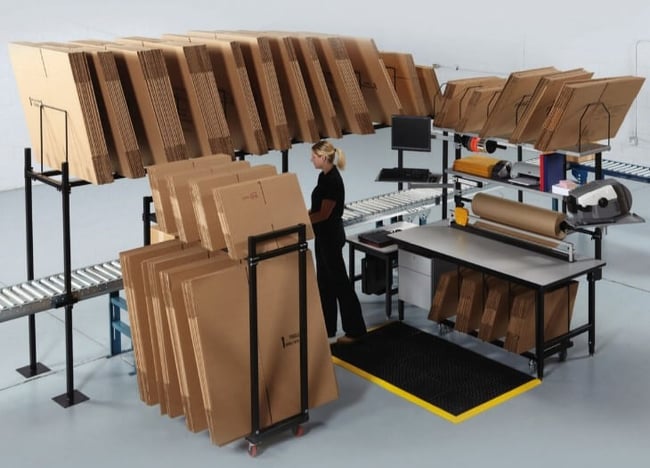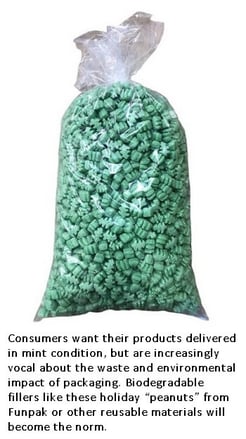
Among the many things that are coming into focus as an unforeseen challenge to every business that had to suddenly ramp up their Ecommerce efforts last year is “packaging”. We haven’t covered it in detail yet, but it did create some serious issues in many DCs last year, both for outbound shipments and the inbound returns. While it might seem like an afterthought in the big picture of running a warehouse, it can be a surprisingly big problem that impacts productivity, customer satisfaction and even your space management.
What are some of the typical problems we see across many facilities? Empty carton space, excessive fillers, unpopular non-recyclable materials and lack of automation all contribute to the headaches experienced by businesses that were forced to ramp up their Ecommerce operations in a hurry.
Here are four common areas to focus on to help your packaging process keep up with the rest of your Ecommerce evolution:
Proper Packing Stations
 One VERY common gap we see out there – especially with businesses that had little or no previous experience shipping single customer orders, is a poorly organized packing area. While this is technically not part of the definition of “packaging”, it’s a big part of the “packaging” process. Setting up a plain table was probably all you could do when this started, but now it’s time to get a proper packing station. Professional packing stations provide adequate storage for your cartons, fillers, tape, printers, etc. and organize them ergonomically to make it easy for the packer to access them.
One VERY common gap we see out there – especially with businesses that had little or no previous experience shipping single customer orders, is a poorly organized packing area. While this is technically not part of the definition of “packaging”, it’s a big part of the “packaging” process. Setting up a plain table was probably all you could do when this started, but now it’s time to get a proper packing station. Professional packing stations provide adequate storage for your cartons, fillers, tape, printers, etc. and organize them ergonomically to make it easy for the packer to access them.
The station shown at the right (and on the cover) from Dehnco Equipment is just one example of the type of professional equipment required to ensure your packing staff are equipped to meet a higher standard than where you started last year.
Right-Sizing Your Cartons
Let’s start on this by reassuring you that there actually is no right answer for how many different size cartons do you need? There actually is no right answer, but there will always be a “too few” and “too many”. But with modern software, often built into many WMS systems, and the use of a dimensioning scale, you can optimize not only the number of carton sizes, but the exactly the right carton for each individual order being packed based on the total dimensions and weight of the enclosed items. Optimizing carton size comes with plenty of benefits:
- Better product protection
- Reduced waste (of space and packing fillers)
- Lower transportation costs
Recycled, Resuable and Reduced Packaging
 There are MANY reasons to carefully source your package fillers, wrappers and other peripheral packing materials, and not all of them are immediately obvious.
There are MANY reasons to carefully source your package fillers, wrappers and other peripheral packing materials, and not all of them are immediately obvious.
- Consumers are becoming increasingly vocal about overuse of plastics, excess paper or messy fillers. And the worst outcome is a customer not happy about them but is NOT vocal – as they just decline to order again. Waste and recyclability are a higher priority than ever, especially as consumers see the packaging pile up as their use of Ecommerce increased last year.
- Reverse Logistics is another process often overlooked early in the Ecommerce experience, but when you start getting 10-20% of your outgoing orders coming back as returns, you’ll appreciate having them arrive in packaging that can either be reused or easily broken down and recycled. The returns process can be extremely labor intensive, and customers are not trained as packers to use optimized packing and tape, so the breakdown process benefits from making our own packaging reusable.
Automation
Like most warehouse processes, automation is growing at an ever-increasing pace. One of the biggest factors is impacting businesses experiencing a rapid increase in Ecommerce shipments is the labor required. While automation usually implies large-scale investment, there are “starter” options that are affordable for situations where you may have a single SKU or product that can be set up to be packed by machine on demand, or pre-packed to be await labeling when ordered. These basic options, which have been available for over two decades, are easy to implement and can take your biggest sellers off the hands of your floor staff and allow them to focus on the more complex and varied shipments.
On the high end of the scale, there are now ways to automate packing using machines that actually CREATE the box required on demand for the order being shipped, The video above highlights a solution from Quadient that can pack up to 1,100 parcels per hour. As you can see from the video, the machine still requires workers to place the orders in a somewhat organized manner into the feeder where they are then scanned for dimensions and very carefully folds the perfectly sized cut cardboard around the items and seals it up for shipping, While it may be over the top for what you thought you would need when your Ecommerce blew up last year, it is certainly a good option to consider if your future plans include large growth in your direct to consumer business.
As Ecommerce Grows, so Does the Packaging Problem
It’s completely understandable that last year’s “mission” was rightfully focused on “getting it out the door”. Now that your Ecommerce business is here to stay, getting the other supporting processes right will help your shipments become more profitable and reduce the exertion required from your teams by providing the professional, process-driven approach that may not have been available when the initial “emergency” response arose last year. If you have solutions worth sharing, questions or ideas, feel free to reach out to our team anytime.










